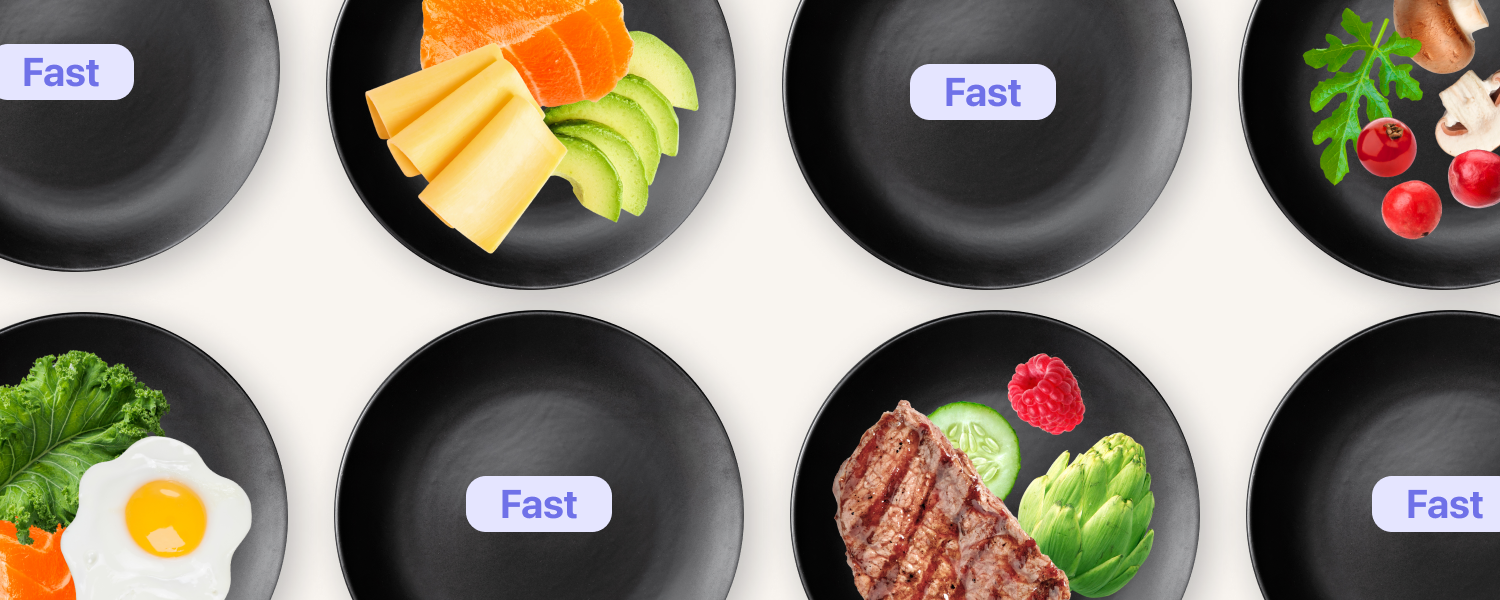Everything you need to know about alternate-day fasting

Alternate-day fasting works exactly as it sounds.
- Eat one day.
- Fast during the next one.
- Alternate throughout the week.
Alternate-day fasting (ADF) is also known as the 4:3 diet because it goes on a 4:3 fast / eat rhythm week by week, like this:

Just like other intermittent fasting methods, you can tailor ADF fasting to suit your needs — there’s no universal “how to do alternate-day fasting” playbook.
But do you really need such an extreme fasting schedule? Or do alternate-day fasting results look similar to results from less intense intermittent fasting schedules?
Let’s dive in.
What is alternate day fasting?

As we’ve seen, alternate-day fasting is:
- fasting every other day, and
- eating as you typically would on the days between.
It’s a pretty straightforward way of creating a caloric deficit, as you’re eating only half as often as you usually would.
Like intermittent fasting in general, it can also improve your health. There are several benefits to intermittent fasting “alternate-day” style that are well supported by research. More on that later, but for now, here’s the general idea:
ADF fasting is eating, then fasting, flip-flopping each day.
While it may sound simple in theory, in practice, it poses a big challenge: whether you’re doing a strict fast or eating a small number of calories on fasting days, it takes a lot of discipline and careful meal planning to practice safely and ensure you’re still getting what you need to thrive, physically and mentally. That’s why you should always involve your healthcare provider in the planning process.
FYI: We much prefer an approach called time-restricted eating. With this method, you fast for several hours, most likely overnight, then enjoy an “eating window” of normal eating. It’s much easier on your body, mind, and soul and still offers the same potential benefits.
For now, if you do have a doctor on board, let’s look at how you might approach ADF.
How to do alternate-day fasting
An ADF fasting schedule roughly works out to around 36 fasting hours and 12 eating hours, on repeat. It looks something like this:
Monday: Eat 8 AM–8 PM
Tuesday: Fast
Wednesday: Eat 8 AM–8 PM
Thursday: Fast
Friday: Eat 8 AM–8 PM
Saturday: Fast
You get the idea.
You could do ADF strict, where you eat zero calories on fast days. Or you could do modified fasts where you eat 500/600 calories on your fast days. Much of the research on alternate-day intermittent fasting was actually done on modified ADF, and the results stack up well.
Either way, going completely without food or with only a fraction of your standard caloric intake every other day is a tall order — you’re asking your body to go without food more frequently than (most likely) you ever have before.
Naturally, hunger can be a significant challenge, as can making sure you’re getting enough nutrition overall. This nutritional support is crucial to support your body’s needs so that ADF results in you thriving, both physically and psychologically, from the experience. That’s why — without the support and supervision of your healthcare team — we don’t recommend any form of fasting that lasts 18+ hours.
Alternate-day fasting schedule and meal plan
If your healthcare team is on board with ADF, there’s one key thing to remember when building your alternate-day fasting meal plan:
Like with any intermittent fasting schedule, it should suit you: your lifestyle, your body, your goals, and your needs.
On a non-fasting day, you can eat:
- when you want
- what you want
Hunger will be part of your ADF fasting experience (at least at first), so our simple advice is to build your diet around lean proteins, healthy fats, veggies and fruits, and whole grain carbohydrates, i.e., foods that:
- satisfy hunger
- keep you feeling full
- enrich your energy
- control cravings
On a fasting day, if you’re modifying your fast, follow the same principles. You can also explore our guide on how to build a meal plan, which can be adapted to any fasting schedule and dietary requirements.
If you’re wondering what you can drink while fasting, water, unsweetened tea, and coffee will help you most. When you only have 500/600 calories to play with, you want each one to count, so allocate them to your food and let your drinks take care of hydration.
Whether it’s a fasting day or not, time your meals in a way that:
- gives you sustained energy all day
- helps you make good choices
For example, you can experiment with eating more food earlier in the day or later. You can also play around with having smaller meals more often or having fewer meals that are larger.
You can drip feed small snacks through your day, open your fast day with a meal to shorten the fasting window, plonk a 500-calorie dinner into the mix, follow a breakfast-lunch-dinner pattern — you can cut it up any way you like.
However you play it, make it work for you. This advice holds true for any fasting schedule — or really any eating routine! For help finding a schedule that suits you, try the easy-to-use Simple app to track your meals and fasting hours.

Alternate-day fasting and hunger
What happened the last time you felt really hungry? Most likely, your stomach growled loudly, your brain filled with fog, and you were disproportionately irritated with the world around you. Maybe you felt a bit woozy, light-headed, shaky, or cold, and your mind filled with incessant thoughts of food.
However it went down, it wasn’t fun, and you probably would’ve eaten curried cardboard if it had been offered to you at that moment.
Hunger is the main adversary of the ADF faster, but all is not lost! There are ways to hack hunger while fasting. Here are some strategies to conquer it:
- Follow a modified ADF fasting approach. Research suggests that hunger will pass in a couple of weeks with modified ADF but not with strict ADF.
- Drink lots of water.
- Distract yourself. Play hopscotch, do a puzzle, play a game of charades with your cat — whatever you find diverting, productive, and engaging.
- Eat good quality, nutritious food.
Most of all, expect that hunger will be around, at least in the early stages of your ADF adventure. While it will likely fade as your body adjusts, listen to your body and take a break if and when you need to. If something doesn’t feel quite right, stop fasting and check in with your healthcare team before trying again.
8 tips for implementing an alternate-day fasting diet
- Listen to your body
If you feel tired, irritable, hungry, etc., when you’re ADF fasting, how can you help yourself feel better? Try some things — sleep more, listen to uplifting music, go for a walk, etc.
If those feelings persist, it may mean ADF isn’t for you, and that’s OK. Keep working with your healthcare team to adjust your approach. And remember that there are several different intermittent fasting schedules out there to choose from.
- Plan ahead
Know what and when you are going to eat so when life gets busy and stressful, you can keep moving forward, especially on fast days. We all know how loudly take-out food can call your name if you aren’t ready and armed with pre-planned meal ideas.
- Stay hydrated
Staying hydrated when you’re alternate-day intermittent fasting is crucial. If remembering to drink is hard (you’re not alone!), try putting a water bottle close at hand or setting alarms to remind yourself to hydrate during fasts.
To give you even more of a leg-up in the hydration game, take our Simple quiz and get your hands on our hydration tracker (as well as a fasting buddy). We’ll send you reminders to drink, so the only thing you’ll have to worry about is whether you want to add some lemon or mint to that next glass of water.
- Modify your fast days
Make your ADF life easy and modify the fast days from 0 calories to 500/600. It’s just as effective, if not more so, because it’s easier to stick to. You’ve heard the adage, “The diet that works best is the diet you can do,” so if excessive hunger is getting you down, stop being a hero and modify!
- Eat well and enjoy your food
Don’t just consume nutritious, filling food like protein, veggies, whole grains, and healthy fats — enjoy them! No one wants you to live on dry chicken breast and boiled broccoli. Grab your cookbooks, throw on an apron, and get creative with tasty-ing up your ADF diet.
- Know your why
Why are you doing this? What difference do you hope it’ll make? Get deep here; really draw out your purpose for embracing the ADF fasting life. Then write it down, paint it, choreograph it into a dance routine, etc. — however you express it, make sure you capture it and connect to it often.
- Notice how foods make you feel
Perhaps a bowl of oats and berries in the morning makes you feel comfortable and content on a fast day, but turkey and bean chili makes your stomach grouchy (and gassy, but let’s keep that between us). Just because a food is healthy doesn’t mean it’s good for you, so get curious about what helps you to feel and function well.
If some friendly feedback would help here, try logging your food in our free Simple app.
- Find what works for you
Tailor your ADF experience to fit you.
From how you structure your fast / non-fast days to what you eat and drink, how you manage hunger, and how you measure success — it’s your call. Just always remember to run any changes by your healthcare team.
Alternate-day fasting and weight loss

There is lots of evidence to back up ADF’s effects on weight loss. Multiple studies suggest that ADF is effective at reducing body weight and body fat.[1,2]
Other studies suggest that alternate-day fasting’s weight loss results are on par with traditional calorie-restricted diets,[3] though this research suggests ADF may have some advantages in terms of fat loss and muscle preservation.[4]
While some studies suggest that ADF may have a slight edge over other approaches when it comes to weight loss,[5] we would still recommend trying other fasting approaches first since they’re easier to manage.
One final interesting thing: Some studies suggest ADF may reduce the compensatory hunger we often feel when restricting calories.[6] This means that feeling where you want to eat ALL THE THINGS because you’ve been eating less doesn’t happen as much with ADF. Cool!
Alternate-day fasting results
The concrete results are strong: ADF fasting can help people lose up to 6% of their body weight in up to 12 weeks.[2]
If weight loss is your goal, here are some insights into what gets results:[7]
- solid protein intake
- feeling satisfied with what you eat
- keeping hunger under control
- sticking with your plan
It’s good advice that applies to any fasting schedule!
To boost your alternate-day fasting results even more, try endurance training. Studies have shown that endurance exercise can result in up to twice as much weight loss as ADF alone![8]
However, keep in mind that, as in any clinical study, these fasters had medical support and supervision. You should always involve your healthcare team if you’re going to try even a modified approach to ADF.
Psst: there’s also plenty of evidence that shows less intense intermittent fasting schedules lead to great results, too![9]
Health benefits and risks of alternate-day fasting
Beyond weight loss, alternate-day fasting — or any intermittent fasting schedule, for that matter! — has many benefits.
Lower risk of diabetes
ADF can improve your insulin sensitivity, HbA1c, and insulin resistance and reduce your fasting glucose and fasting insulin, reducing your risk of developing type 2 diabetes.[10,11]
Improved cholesterol levels
Alternate-day intermittent fasting can drop your LDL and triglycerides, improving your cholesterol levels.[5]

Improved heart disease risk factors
ADF can boost your heart health through better blood pressure, lower cholesterol, and reduced inflammation.[12,13]
Improved body composition
In addition to weight loss, ADF can help you reduce belly fat, lower body fat overall, and potentially increase muscle mass.[13,14]
The risks
As for the risks, ADF does tend to bring up more potential risks than less restrictive fasting schedules.
You already know about hunger — it can be fierce, but it’s short-term, and there are ways to manage it.
You may also feel tired, cold, grumpy, and have trouble sleeping. Again, these should pass. If they don’t, another intermittent fasting schedule might suit you better.
Is alternate-day fasting safe?
Again, we don’t typically recommend ADF — its level of restriction means it can introduce more potential risks and safety concerns compared to a less restrictive fasting approach.
While everyone who’s considering any type of intermittent fasting should have conversations with their healthcare team, you should be particularly cautious if you:
- have type 1 diabetes;
- are pregnant, breastfeeding, or trying to conceive;
- are prescribed medication (like hypertensives or any medications that need to be taken with food);
- have a history of or are currently diagnosed with disordered eating;
- are extremely active;
- have a BMI of less than 18.5; or
- are under 18 or 80 years or older.
If you do decide to try ADF, talk to your doctor first and make sure you are fully supported by a health professional.
We need to talk about women here, too — particularly, intermittent fasting and hormones. Calorie restriction can impact women’s menstrual cycle and heighten the stress response, as female bodies are quite sensitive to changes in energy balance.
If this affects you, we’d encourage you to start your intermittent fasting journey with the 12:12 approach and work up to ADF fasting if it feels good (and if your doctor is fully on board).
Alternate-day fasting drawbacks and the best ways to avoid them
You might overeat.
Coming off the back of a fast day, you may feel super hungry and eat too much. In the early stages of your ADF diet, this is to be expected, so don’t sweat it!
It takes time to get used to a new way of eating; most likely, you’ll make some classic intermittent fasting mistakes. Think of a time you learned something new, like driving a car or even the lyrics of a song you like. You didn’t have it down on day one, right? The same applies here. Be patient with yourself.
You might feel sleepy, grumpy, or dopey.
Not that you’ll transform into one of Snow White’s seven dwarves, but the impact of cutting back significantly on your calories every other day can affect your energy levels, your mood, and your ability to think clearly.
Don’t worry — these effects will pass.
You might forget that life (and food) is to be enjoyed.
Following a diet like the alternate-day fasting diet can make you over-focus on food — especially initially, due to hunger — and get hung up on doing everything “perfectly.”
Remember: ADF works for you. It’s meant to be a supportive method of achieving your goals. Explore how you can make ADF work, see how you get on, and — if it all feels too much — don’t be scared to try another option.
Is alternate-day fasting right for you?

Now that you have all the information, it’s bottom line time:
Is alternate-day fasting right for you?
Yes, if you:
- like the simplicity and structure of fasting for one day and eating the next
- can safely get on with eating 0–600 calories every second day
- you’re an experienced faster and meal-planner
- have goals that ADF fasting can help you achieve
- are not in any of these groups
Then it sounds like you’re ready to book an appointment to discuss it with your healthcare team!
No, if you:
- think this all sounds rather hardcore and difficult
- prefer a gentler intermittent fasting approach
- are represented in this list
That’s OK. There are other possibilities that might suit you better.
First up, our favorite and most recommended fasting method: time-restricted eating.
ADF fasting vs. intermittent fasting 16:8
With intermittent fasting 16:8, you consume all your calories over eight hours and fast for the remaining 16. The fasting period is up to you, and it’s far shorter than with ADF, making hunger and potential side effects or nutritional deficiencies less of an issue. There’s no need to count calories, either.
It’s an excellent option for getting used to intermittent fasting, and if 16:8 feels too hard, you could try a different approach, like 12-hour intermittent fasting or 14:10 intermittent fasting. They’re our most recommended fasting schedules for a reason! The downside is that 16:8 fasting is something you do every day, which can be more disruptive to your family or social life.
Now, let’s look at some other alternative schedules (that we aren’t as big of fans of).
ADF fasting vs. the Warrior Diet
The Warrior Diet is a 20-hour fast followed by a four-hour eating window in the evening. It’s still quite tough to get all your food into 4 hours — remember: we don’t recommend fasting 18+ hours unless you have medical supervision — but the fasts are shorter than ADF, and that may feel more manageable.
ADF fasting vs. 5:2 fasting
With 5:2 fasting, you fast two days a week and eat as you typically would on the other five. Like ADF, not fasting every day might fit your life better and as there are fewer fasting days per week, hunger is less of a challenge. But it’s still pretty restrictive and involves fasting for over 18 hours, and we don’t recommend fasts of this length unless you’re working closely with your healthcare team.
ADF fasting vs. one meal a day (OMAD).
OMAD requires you to fast for 23 hours and eat all your nutrients in a one-hour window. You can schedule that one-hour window whenever you like, but overall, it’s more restrictive than ADF, and we don’t recommend it.
ADF fasting vs. water fasting. With water fasting, you consume only water for 24–72 hours. It’s a short-term option that’s quite extreme, and we don’t recommend you try it.
How much weight you can lose on alternate-day fasting is similar to traditional diets. The science suggests you can expect around a 4%–8% reduction in body weight over six to 12 weeks.[13]
You sure can! For the best results, however, shoot for foods that nourish your body.
What you do afterward determines what happens when you stop alternate-day fasting. If you return to how you were eating before, you’ll likely lose any benefits you gained. However, if you maintain your positive habits, you’ll likely keep them.
Whether alternate-day fasting is good for you depends on who you are. Some people need to avoid it, like those with diabetes, pregnant people, and those who have eating disorders. Other people may see health benefits, but other less extreme fasting schedules can give you those, too.
Your results from intermittent fasting will be influenced by many factors, but your actions are key. Stay consistent, make wise choices, and you’ll find it doesn’t take long to see results with alternate-day fasting.
Some medications do break intermittent fasting, but medication takes precedence over fasting in terms of looking after your health. And, if you are on medications, always talk to your doctor before starting intermittent fasting.
Fair point! For men, intermittent fasting can offer excellent results. If you’re intrigued whether it’ll suit you, try it out. It might be right up your alley.

- Tinsley GM, La Bounty PM. Effects of intermittent fasting on body composition and clinical health markers in humans. Nutr Rev. 2015 Oct;73(10):661–74.
- Varady KA, Bhutani S, Klempel MC, Kroeger CM, Trepanowski JF, Haus JM, et al. Alternate day fasting for weight loss in normal weight and overweight subjects: a randomized controlled trial. Nutr J. 2013 Nov 12;12(1):146.
- Trepanowski JF, Kroeger CM, Barnosky A, Klempel MC, Bhutani S, Hoddy KK, et al. Effect of Alternate-Day Fasting on Weight Loss, Weight Maintenance, and Cardioprotection Among Metabolically Healthy Obese Adults: A Randomized Clinical Trial. JAMA Intern Med. 2017 Jul 1;177(7):930–8.
- Alhamdan BA, Garcia-Alvarez A, Alzahrnai AH, Karanxha J, Stretchberry DR, Contrera KJ, et al. Alternate-day versus daily energy restriction diets: which is more effective for weight loss? A systematic review and meta-analysis. Obes Sci Pract. 2016 Sep;2(3):293–302.
- Patikorn C, Roubal K, Veettil SK, Chandran V, Pham T, Lee YY, et al. Intermittent Fasting and Obesity-Related Health Outcomes: An Umbrella Review of Meta-analyses of Randomized Clinical Trials. JAMA Netw Open. 2021 Dec 1;4(12):e2139558.
- Klempel MC, Bhutani S, Fitzgibbon M, Freels S, Varady KA. Dietary and physical activity adaptations to alternate day modified fasting: implications for optimal weight loss. Nutr J. 2010 Sep 3;9:35.
- Kroeger CM, Trepanowski JF, Klempel MC, Barnosky A, Bhutani S, Gabel K, et al. Eating behavior traits of successful weight losers during 12 months of alternate-day fasting: An exploratory analysis of a randomized controlled trial. Nutr Health. 2018 Mar;24(1):5–10.
- Bhutani S, Klempel MC, Kroeger CM, Trepanowski JF, Varady KA. Alternate day fasting and endurance exercise combine to reduce body weight and favorably alter plasma lipids in obese humans. Obesity . 2013 Jul;21(7):1370–9.
- Song DK, Kim YW. Beneficial effects of intermittent fasting: a narrative review. J Yeungnam Med Sci. 2023 Jan;40(1):4–11.
- He S, Wang J, Zhang J, Xu J. Intermittent Versus Continuous Energy Restriction for Weight Loss and Metabolic Improvement: A Meta-Analysis and Systematic Review. Obesity . 2021 Jan;29(1):108–15.
- Nowosad K, Sujka M. Effect of Various Types of Intermittent Fasting (IF) on Weight Loss and Improvement of Diabetic Parameters in Human. Curr Nutr Rep. 2021 Jun;10(2):146–54.
- Kroeger CM, Klempel MC, Bhutani S, Trepanowski JF, Tangney CC, Varady KA. Improvement in coronary heart disease risk factors during an intermittent fasting/calorie restriction regimen: Relationship to adipokine modulations. Nutr Metab . 2012 Oct 31;9(1):98.
- Cui Y, Cai T, Zhou Z, Mu Y, Lu Y, Gao Z, et al. Health Effects of Alternate-Day Fasting in Adults: A Systematic Review and Meta-Analysis. Front Nutr. 2020 Nov 24;7:586036.
- Stekovic S, Hofer SJ, Tripolt N, Aon MA, Royer P, Pein L, et al. Alternate Day Fasting Improves Physiological and Molecular Markers of Aging in Healthy, Non-obese Humans. Cell Metab. 2019 Sep 3;30(3):462–76.e6.
